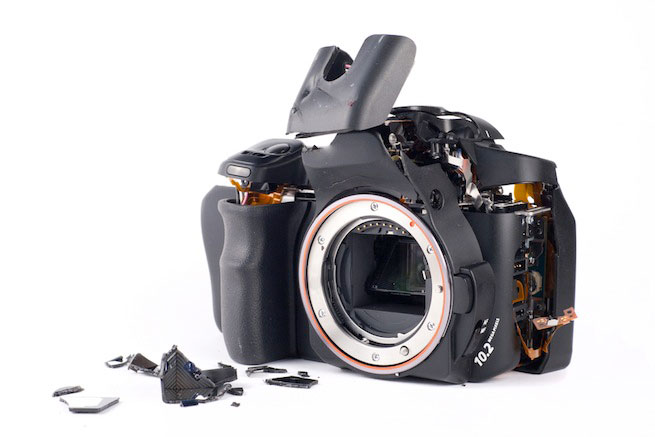Historically, nothing has separated the photo enthusiast from the casual photographer like the sight of a DSLR camera hanging around their neck. However, the camera industry is in transition.
DSLR cameras, which previously occupied leading positions in the manufacturer’s portfolio, are gradually being phased out in favor of lighter, smaller mirrorless cameras.
If you’re a DSLR fan, the long-term outlook might seem bleak, but you can actually benefit from this current shift because the cameras still on sale include some of the best, most refined features offered in their product lines, if not decades. a deep selection of DSLR lenses and accessories that you can take advantage of.
Our top pick is the Canon EOS 5D Mark IV DSLR camera. Packed with features that make taking fantastic photos a breeze, it’s a great choice for anyone looking to get serious about photography, or for those looking to grab perhaps one of the last great DSLRs on the market.
Canon’s Mark IV SLR offers a 30.4-megapixel sensor for shooting in a variety of lighting conditions, as well as a near-instant 61-point autofocus system that lets you reliably capture sharp photos as quickly as possible. It has up to 12 stops of dynamic range, so you can take vivid photos even in dimly lit restaurants or outdoors in the evening. It can record video in 4K resolution and has built-in Wi-Fi to wirelessly transfer images to your computer. Capable of continuous shooting at 7 FPS, the Mark IV is also great for sports and action shots. Users appreciate this camera’s rugged, moisture- and dust-resistant construction, as well as how deeply they can adjust its settings to suit their needs while shooting.
Second in overall value per dollar is the Canon EOS Rebel T7.
Rebel cameras are Canon’s long-standing entry-level product line for those interested in purchasing a DSLR camera without breaking the bank. Fantastic value, this kit includes a camera, a padded carrying case and a pair of lenses to give aspiring photographers a wide range of shooting options. This entry-level camera features Canon’s Scene Intelligent Auto mode, a feature that automatically adjusts the camera’s settings based on your environment to deliver the best possible image. Moving subjects can be photographed at a speed of three frames per second and you can record video in full 1080p HD resolution. Although aimed at beginners, this camera is competent enough for experienced photographers and is fully compatible with Canon’s EF and EF-S lenses.
The third is the Nikon D850.
Nikon’s D850 offers professional performance and gallery-ready results, thanks to its 45.7-megapixel sensor, one of the highest resolutions available on a DSLR camera. Its 7 FPS burst mode is great for capturing moving subjects. Its magnesium alloy body makes the camera weatherproof and safe from shocks and light impacts. A wide range of autofocus options and the ability to record 4K video or 8K time-lapses make this camera attractive to filmmakers as well. Although this kit does not come with a lens, it does include two 64GB memory cards, a card reader, three batteries, two chargers, cleaning tools, lens caps, a shoulder strap and a padded bag for your gear. The Nikon D850 has been on the market for several years and is still an expensive option, but for professionals who need a high-end camera, it has stood the test of time.
The Canon 90D takes fourth place.
Canon’s mid-range DSLR camera doesn’t skimp on features as it includes a 32.5-megapixel sensor and the ability to shoot continuously at 10 FPS. It has built-in Wi-Fi to easily transfer photos to your computer, as well as a Bluetooth connection that you can use to send images to your phone to share with friends or on social media. It can record video in 4K and has a built-in flash and autofocus features that ensure your photos will look great no matter where you shoot. Some professional photographers may struggle with the noise present in this camera’s low-light images, but users looking to move up from a basic DSLR will find this camera’s build, features and image quality to be a significant upgrade.
Nikon’s D7500 holds the fifth position in terms of value.
Those looking for Nikon quality without blowing their budget will find much to appreciate in the D7500. Its 51-point autofocus system enables fast and precise focusing even on moving subjects. The camera’s 3.2-inch touchscreen is hinged, allowing you to tilt and swivel it into a comfortable viewing position. It features Wi-Fi and Bluetooth connectivity, allowing you to wirelessly share photos or use a connected device as a remote control. Special effects allow you to mimic the look of shooting with night vision, a toy camera, or customize your photos with a number of fun filters. It can shoot at 8 FPS and includes the same sensor and processor built into Nikon cameras costing hundreds of dollars more.
Finally, in sixth place is Canon’s former flagship, the EOS 1D X Mark 3.
If you’ve got the cash to spare, this new Canon DSLR is top-of-the-line and is the most advanced model the company will ever make. Built to create beautiful, brilliant photos of moving subjects in nature or sports, the 1D X Mark III can shoot up to 20 FPS and features an incredible 191-point autofocus system that uses deep learning to recognize subjects in the most dynamic, demanding conditions. WiFi, Bluetooth and GPS are built in, and you can record video in up to 5.5K resolution, depending on the format you choose. The 1D X Mark III is bulky and certainly not for the inexperienced, but professional users are amazed by its ability to deliver incredibly detailed footage and will go down in history as Canon’s last flagship in their legendary line of DSLR cameras.
